HP OMNIBOOK XE3-GF Manual

HP Omnibook XE3 (GF)
Corporate Evaluator’s Guide

Notice
Technology Code GF This guide contains information about only the Omnibook XE3, technology code GF. The technology code is shown on the serial-number label on the bottom of the computer, and it is also included in the BIOS version number. Information about models with other technology codes may be available in other guides.
This manual and any examples contained herein are provided “as is” and are subject to change without notice. Hewlett-Packard Company makes no warranty of any kind with regard to this manual, including, but not limited to, the implied warranties of merchantability and fitness for a particular purpose. Hewlett-Packard Co. shall not be liable for any errors or for incidental or consequential damages in connection with the furnishing, performance, or use of this manual or the examples herein.
Consumer transactions in Australia and the United Kingdom: The above disclaimers and limitations shall not apply to Consumer transactions in Australia and the United Kingdom and shall not affect the statutory rights of Consumers.
© Copyright Hewlett-Packard Company 2000–2001. All rights reserved. Reproduction, adaptation, or translation of this manual is prohibited without prior written permission of Hewlett-Packard Company, except as allowed under the copyright laws.
The programs that control this product are copyrighted and all rights are reserved. Reproduction, adaptation, or translation of those programs without prior written permission of Hewlett-Packard Co. is also prohibited.
Portions of the programs that control this product may also be copyrighted by Microsoft Corporation, Phoenix Technologies, Ltd., ESS, S3 Incorporated, Accton, Trident Microsystems Incorporated, Acer Laboratories Incorporated, and Adobe Systems Incorporated. See the individual programs for additional copyright notices.
This product incorporates copyright protection technology that is protected by method claims of certain U.S. patents and other intellectual property rights owned by Macrovision Corporation and other rights owners. Use of this copyright protection technology must be authorized by Macrovision Corporation and is intended for home and other limited viewing uses only unless otherwise authorized by Macrovision Corporation. Reverse engineering or disassembly is prohibited.
Microsoft®, MS-DOS®, and Windows® are U.S. registered trademarks of Microsoft
Corporation. Pentium® and the Intel Inside logo are U.S. registered trademarks and
MMX, Celeron™, and SpeedStep™ are U.S. trademarks of Intel Corporation.
TrackPoint™ is a U.S. trademark of International Business Machines. Adobe® and
Acrobat® are trademarks of Adobe Systems Incorporated.
Hewlett-Packard Company
HP Notebook Customer Care
1000 NE Circle Blvd., MS 425E
Corvallis, OR 97330, U.S.A.
2 Corporate Evaluator’s Guide

HP Software Product License Agreement
Your HP product contains software programs. CAREFULLY READ THIS LICENSE AGREEMENT BEFORE PROCEEDING TO OPERATE THIS EQUIPMENT. RIGHTS IN THE SOFTWARE ARE OFFEREDONLY ON THE CONDITION THAT THE CUSTOMER AGREES TO ALL TERMS AND CONDITIONS OF THE LICENSE AGREEMENT. PROCEEDING TO OPERATE THE EQUIPMENT INDICATES YOUR ACCEPTANCE OF THESE TERMS AND CONDITIONS. IF YOU DO NOT AGREE WITH THE TERMS OF THE LICENSE AGREEMENT, YOU MUST NOW EITHER REMOVE THE SOFTWARE FROM YOUR HARD DISK DRIVE AND DESTROY THE MASTER DISKETTES, OR RETURN THE COMPLETE HP PRODUCT AND SOFTWARE FOR A FULL REFUND. PROCEEDING WITH CONFIGURATION SIGNIFIES YOUR ACCEPTANCE OF THE LICENSE TERMS.
UNLESS OTHERWISE STATED BELOW, THIS HP SOFTWARE LICENSE AGREEMENT SHALL GOVERN THE USE OF ALL SOFTWARE THAT IS PROVIDED TO YOU AS PART OF THE HP PRODUCT AND SHALL SUPERSEDE ANY OTHER SOFTWARE WARRANTY STATEMENT THAT MAY BE INCLUDED IN THIS HP PRODUCT OR MAY BE FOUND ONLINE.
Operating system and software applications by Microsoft are licensed to you under the Microsoft License Agreement contained in the Microsoft documentation or displayed on your screen when Microsoft Software Products are launched. Other non-HP Software and Operating Systems are covered by the appropriate vendor license. The following License Terms govern the use of the HP software:
USE. Customer may use the software on any one HP product. Customer may not network the software or otherwise use it on more than one HP product. Customer may not reverse assemble or decompile the software unless authorized by law.
COPIES AND ADAPTATIONS. Customer may make copies or adaptations of the software a) for archival purposes or (b) when copying or adaptation is an essential step in the use of the software with an HP product so long as the copies and adaptations are used in no other manner.
OWNERSHIP. Customer agrees that he/she does not have any title or ownership of the software, other than ownership of the physical media. Customer acknowledges and agrees that the software is copyrighted and protected under the copyright laws. Customer acknowledges and agrees that the software may have been developed by a third party software supplier named in the copyright notices included with the software, who shall be authorized to hold the Customer responsible for any copyright infringement or violation of this Agreement.
PRODUCT RECOVERY CD. If your HP product was shipped with a product Recovery CD: (i) The product Recovery CD and/or support utility software may only be used for restoring the hard disk of the HP product with which the product Recovery CD was originally provided. (ii) The use of any operating system software by Microsoft contained in any such product Recovery CD shall be governed by the Microsoft License Agreement.
Corporate Evaluator’s Guide |
3 |

TRANSFER OF RIGHTS IN SOFTWARE. Customer may transfer rights in the software to a third party only as part of the transfer of all rights and only if Customer obtains the prior agreement of the third party to be bound by the terms of this License Agreement. Upon such a transfer, Customer agrees that his/her rights in the software are terminated and that he/she will either destroy his/her copies and adaptations or deliver them to the third party.
SUBLICENSING AND DISTRIBUTION. Customer may not lease, sublicense the software or distribute copies or adaptations of the software to the public in physical media or by telecommunication without the prior written consent of Hewlett-Packard.
TERMINATION. Hewlett-Packard may terminate this software license for failure to comply with any of these terms provided Hewlett-Packard has requested Customer to cure the failure and Customer has failed to do so within thirty (30) days of such notice.
UPDATES AND UPGRADES. Customer agrees that the software does not include updates and upgrades which may be available from Hewlett-Packard under a separate support agreement.
EXPORT CLAUSE. Customer agrees not to export or re-export the software or any copy or adaptation in violation of the U.S. Export Administration regulations or other applicable regulation.
U.S. GOVERNMENT RESTRICTED RIGHTS. Use, duplication, or disclosure is subject to HP standard commercial license terms and for non-DOD Departments and Agencies of the U.S. Government, the restrictions set forth in FAR 52.227-19(c)(1-2) (June 1987)
Hewlett-Packard Company, 3000 Hanover Street, Palo Alto, CA 94304 U.S.A. Copyright
(c) 2000–2001 Hewlett-Packard Company. All Rights Reserved. Customer further agrees that Software is delivered and licensed as “Commercial computer software” as defined in DFARS 252-227-7014 (June 1995) or as a “commercial item” as defined in FAR 2.101(a), or as “Restricted computer software” as defined in FAR 52.227-19 (or any equivalent agency regulation or contract clause), whichever is applicable. The Customer agrees that it has only those rights provided for such Software by the applicable FAR or DFARS clause or the HP standard software agreement for the product involved.
Support Policy for Support Pack of Operating Systems. HP provides end user support for HP PCs that use Microsoft Operating Systems, including its latest service packs. This support will be available within 30 days of the software being released.
Edition History
Edition 4 (GF) ........................................ |
January 2002 |
 This manual is printed on recycled paper.
This manual is printed on recycled paper.
4 Corporate Evaluator’s Guide

Contents |
|
Introducing Your Computer ......................................................................................... |
11 |
Comparing Omnibook XE3 Models ........................................................................... |
12 |
Taking Inventory ........................................................................................................ |
14 |
To buy accessories ................................................................................................ |
14 |
To find more information...................................................................................... |
15 |
Identifying Parts of the Notebook............................................................................... |
16 |
Top and right side view......................................................................................... |
16 |
Front view ............................................................................................................. |
17 |
Rear and left side view.......................................................................................... |
18 |
Bottom view.......................................................................................................... |
19 |
Status lights ........................................................................................................... |
20 |
Multimedia buttons ............................................................................................... |
21 |
Status panel ........................................................................................................... |
22 |
Setting Up the Computer ............................................................................................ |
23 |
To install the battery ............................................................................................. |
23 |
To connect AC power ........................................................................................... |
24 |
To connect a phone line ........................................................................................ |
25 |
To turn on the computer........................................................................................ |
25 |
To set up Windows ............................................................................................... |
26 |
To register your computer..................................................................................... |
27 |
To connect to an Internet Service Provider........................................................... |
29 |
To reset your computer ......................................................................................... |
30 |
Using Your Computer .................................................................................................... |
31 |
Operating the Computer ............................................................................................. |
32 |
To use the Fn hot keys .......................................................................................... |
32 |
To use the Windows and Applications keys ......................................................... |
33 |
To use the embedded keypad ................................................................................ |
34 |
To use the ALT GR key ........................................................................................ |
34 |
To adjust the display ............................................................................................. |
35 |
To adjust the volume............................................................................................. |
36 |
To use the touch pad ............................................................................................. |
37 |
To change the boot device .................................................................................... |
38 |
To use the One-Touch buttons .............................................................................. |
39 |
To insert or remove a CD or DVD........................................................................ |
40 |
To play DVDs ....................................................................................................... |
40 |
To create or copy CDs .......................................................................................... |
41 |
Securing the Computer ............................................................................................... |
42 |
To set up password protection .............................................................................. |
42 |
To attach a security cable...................................................................................... |
44 |
To use virus-protection software........................................................................... |
45 |
Working in Comfort with a Notebook PC .................................................................. |
46 |
Caring for Your Computer.......................................................................................... |
48 |
Corporate Evaluator’s Guide |
5 |

To protect your hard disk drive............................................................................. |
48 |
To take care of your computer .............................................................................. |
48 |
To safeguard your data.......................................................................................... |
49 |
To extend the life of the display............................................................................ |
49 |
To get the most from your batteries ...................................................................... |
50 |
To clean your computer ........................................................................................ |
50 |
Traveling with Your Computer .................................................................................... |
51 |
Managing Power Consumption .................................................................................. |
52 |
To use automated power management.................................................................. |
52 |
To use manual power management....................................................................... |
55 |
Using Battery Power................................................................................................... |
58 |
To check the battery status.................................................................................... |
58 |
To respond to a low-battery warning .................................................................... |
59 |
To optimize battery operating time ....................................................................... |
60 |
To control the processor speed with SpeedStep.................................................... |
60 |
Making Connections....................................................................................................... |
61 |
Using the Modem ....................................................................................................... |
62 |
Important safety information ................................................................................ |
62 |
To connect the modem .......................................................................................... |
63 |
To connect to the Internet ..................................................................................... |
64 |
To disconnect from the Internet ............................................................................ |
65 |
To dial in to a network .......................................................................................... |
66 |
To change your modem settings ........................................................................... |
66 |
To send and receive e-mail ................................................................................... |
67 |
To send and receive faxes (Windows 98) ............................................................. |
68 |
To send and receive faxes (Windows 2000) ......................................................... |
69 |
To send and receive faxes (Windows XP) ............................................................ |
70 |
Connecting to a LAN.................................................................................................. |
71 |
Connecting PC Cards.................................................................................................. |
72 |
Connecting External Components .............................................................................. |
74 |
To identify the ports.............................................................................................. |
74 |
To connect a printer or another parallel device..................................................... |
76 |
To connect an external keyboard or PS/2 mouse .................................................. |
76 |
To connect a USB device...................................................................................... |
76 |
To connect audio devices ...................................................................................... |
77 |
To use infrared devices ......................................................................................... |
77 |
To use an external monitor.................................................................................... |
79 |
To use a TV set as monitor ................................................................................... |
81 |
To use the port replicator ...................................................................................... |
82 |
To connect an IEEE1394 device ........................................................................... |
84 |
Configuring and Expanding Your Computer.............................................................. |
85 |
Using the BIOS Setup Utility ..................................................................................... |
86 |
Installing RAM Modules ............................................................................................ |
87 |
6 Corporate Evaluator’s Guide

To install a RAM expansion module .................................................................... |
87 |
To remove a RAM expansion module .................................................................. |
88 |
To replace the system RAM module..................................................................... |
89 |
Expanding the Hibernate Partition (Windows 98)...................................................... |
90 |
Updating Windows Drivers ........................................................................................ |
91 |
Using Windows XP ......................................................................................................... |
93 |
Installing Retail Windows XP .................................................................................... |
94 |
Requirements ........................................................................................................ |
94 |
To prepare for software installation ...................................................................... |
95 |
To install retail Windows XP................................................................................ |
96 |
To install video support......................................................................................... |
97 |
To install audio support......................................................................................... |
98 |
To install modem support ..................................................................................... |
98 |
To install integrated LAN support ........................................................................ |
98 |
To install wireless LAN support ........................................................................... |
99 |
To install the HP Display Settings and Configuration Interface (HPCI) utility... 99 |
|
To install touchpad support................................................................................. |
100 |
To install support for the USB-to-serial dongle.................................................. |
100 |
To install the OneTouch utility ........................................................................... |
101 |
To install the Desktop Zoom utility .................................................................... |
101 |
To install the Java Virtual Machine .................................................................... |
101 |
To configure Windows XP power management ................................................. |
101 |
Using Windows 2000 .................................................................................................... |
103 |
Installing Retail Windows 2000 ............................................................................... |
104 |
Requirements ...................................................................................................... |
104 |
To prepare for software installation .................................................................... |
105 |
To install retail Windows 2000 ........................................................................... |
106 |
To install chipset support .................................................................................... |
107 |
To install video support....................................................................................... |
107 |
To install audio support....................................................................................... |
107 |
To install modem support ................................................................................... |
108 |
To install integrated LAN support ...................................................................... |
108 |
To install touchpad support................................................................................. |
109 |
To install the Intel® SpeedStep™ technology applet ......................................... |
109 |
To install infrared support................................................................................... |
109 |
To install the USB-to-serial dongle .................................................................... |
110 |
To install HP Display Settings and Configuration Interface (HPCI) ................. |
111 |
To install the OneTouch utility ........................................................................... |
111 |
To install the Desktop Zoom utility .................................................................... |
112 |
To configure Windows 2000 power management .............................................. |
112 |
Using Windows 98 ........................................................................................................ |
113 |
Installing Retail Windows 98 Second Edition .......................................................... |
114 |
Requirements ...................................................................................................... |
114 |
Corporate Evaluator’s Guide |
7 |

To prepare for software installation .................................................................... |
115 |
To install a retail version of Windows 98 Second Edition.................................. |
116 |
To install chipset support .................................................................................... |
117 |
To install video support....................................................................................... |
117 |
To install audio support....................................................................................... |
118 |
To install modem support ................................................................................... |
118 |
To install integrated LAN support ...................................................................... |
118 |
To install PCMCIA controller support................................................................ |
119 |
To install touchpad support................................................................................. |
120 |
To install the Intel® SpeedStep™ applet............................................................ |
120 |
To install infrared support................................................................................... |
121 |
To install the USB-to-serial dongle .................................................................... |
121 |
To install DirectX version 8.0............................................................................. |
121 |
To install software patches for retail Windows 98 Second Edition .................... |
122 |
To install the OneTouch utility ........................................................................... |
123 |
To install the Desktop Zoom utility .................................................................... |
123 |
To configure recommended Windows 98 Power Management .......................... |
124 |
Service and Support ..................................................................................................... |
125 |
Hewlett-Packard Limited Warranty Statement ......................................................... |
126 |
Getting Support for Your HP Notebook PC ............................................................. |
128 |
To use the Reference Guide ................................................................................ |
128 |
To get help from the HP notebook web site........................................................ |
128 |
To call HP for service and support...................................................................... |
129 |
Obtaining Repair Service.......................................................................................... |
132 |
To receive warranty repair service ...................................................................... |
132 |
To prepare your computer for shipment ............................................................. |
133 |
Solving Problems with Your Computer ..................................................................... |
135 |
Troubleshooting Techniques .................................................................................... |
136 |
Audio problems................................................................................................... |
136 |
CD and DVD problems....................................................................................... |
137 |
Display problems ................................................................................................ |
138 |
Hard disk drive problems .................................................................................... |
140 |
Heat problems ..................................................................................................... |
141 |
Infrared Problems................................................................................................ |
141 |
Keyboard, touch pad, and mouse problems ........................................................ |
142 |
LAN problems .................................................................................................... |
143 |
Memory problems ............................................................................................... |
144 |
Modem problems ................................................................................................ |
145 |
One-Touch button problems ............................................................................... |
149 |
Parallel and USB problems ................................................................................. |
150 |
PC card (PCMCIA) problems ............................................................................. |
150 |
Performance problems ........................................................................................ |
151 |
Port replicator problems...................................................................................... |
152 |
Power and battery problems................................................................................ |
152 |
Printing problems................................................................................................ |
154 |
8 Corporate Evaluator’s Guide

Startup problems ................................................................................................. |
155 |
Standby and resume problems ............................................................................ |
156 |
Testing Hardware Operation..................................................................................... |
157 |
Recovering and Reinstalling Software ..................................................................... |
159 |
To recover the factory installation of your hard disk .......................................... |
159 |
To replace a damaged Recovery CD ................................................................... |
160 |
To update the HP notebook BIOS....................................................................... |
160 |
To recover an application.................................................................................... |
161 |
Specifications and Regulatory Information ............................................................... |
163 |
Hardware and Software Specifications..................................................................... |
164 |
BIOS Setup utility options .................................................................................. |
164 |
Hardware specifications ...................................................................................... |
167 |
Modem Reference Information................................................................................. |
169 |
AT commands (Ambit) ....................................................................................... |
169 |
S-registers (Ambit).............................................................................................. |
174 |
Selected result codes (Ambit) ............................................................................. |
175 |
Safety Information .................................................................................................... |
176 |
Power cords......................................................................................................... |
176 |
Battery safety ...................................................................................................... |
177 |
Laser safety ......................................................................................................... |
178 |
LED safety .......................................................................................................... |
178 |
Regulatory Information ............................................................................................ |
179 |
U.S.A................................................................................................................... |
179 |
Canada................................................................................................................. |
180 |
European Union .................................................................................................. |
181 |
Japan ................................................................................................................... |
183 |
Russia .................................................................................................................. |
183 |
International ........................................................................................................ |
183 |
Index .............................................................................................................................. |
185 |
Corporate Evaluator’s Guide |
9 |

Introducing Your Computer
Corporate Evaluator’s Guide |
11 |

Introducing Your Computer
Comparing Omnibook XE3 Models
Comparing Omnibook XE3 Models
Technology Code
Physical Attributes
Processor
Chip Set
SDRAM
Graphics Controller
This guide contains information about only the Omnibook XE3, technology code GF. The technology code is shown on the serial-number label on the bottom of the computer, and it is also included in the BIOS version number. Information about models with other technology codes may be presented in other guides.
The following table shows some key differences among the different versions of Omnibook XE3 models.
GC |
GD |
GE |
GF |
Size:
13.03" x 10.76" x 1.59" (331 x 273.3 x 40.4mm) for 12.1”, 13.0”, 13.3", 14.1" TFT and HPA LCD. 13.03" x 10.87" x 1.63" (342 x 276.6 x 41.5mm) for 15" TFT LCD.
Weight: |
|
Weight: |
Weight: |
|
6.9lbs (3.15 kg) min. |
|
7.2lbs (3.26 kg) min. |
7.4lbs (3.36kg) min. |
|
Intel Pentium III |
AMD Mobile Athlon4 |
AMD Mobile Athlon4 |
Intel Mobile Pentium |
|
600/650/700/750/800/ |
900/1000 MHz with |
900/950/1000/ |
III 866/933/1060/ |
|
850/900/1000 MHz |
PowerNow |
1100MHz with |
1130MHz with |
|
with SpeedStep. |
AMD Mobile Duron |
PowerNow |
SpeedStep |
|
|
|
|
||
Intel Celeron |
800/850 MHz with |
AMD Mobile Duron |
Intel Celeron |
|
500/550/600/650/700/ |
PowerNow |
900 MHz with |
800/866/933 MHz |
|
750/800/850 MHz |
200MHz FSB |
PowerNow |
133MHz FSB |
|
100MHz FSB |
200MHz FSB |
|||
|
|
|||
Intel 440ZXM-100 |
Ali M1647+ M1535+ |
|
Intel 830MG |
|
133 MHz SDRAM |
133 MHz SDRAM (PC133) running at 100MHz. |
133 MHz SDRAM |
||
(PC133) running at |
Max memory: 512 MB, using two 256-MB |
(PC133). |
||
100MHz. |
Max memory: 1GB, |
|||
modules. |
|
|||
|
|
|||
Max memory: 512 |
|
|
using two 512-MB |
|
MB, using two 256- |
|
|
modules. |
|
MB modules. |
|
|
|
|
PC100 memory was |
|
|
|
|
qualified for use on |
|
|
|
|
early models, but not |
|
|
|
|
on later models. If unit |
|
|
|
|
was shipped with |
|
|
|
|
PC133 memory, do |
|
|
|
|
not use PC100 |
|
|
|
|
memory. |
|
|
|
|
S3 Savage/IX with 4 |
Trident CBXP + 8 MB SGRAM. |
Intel 830MG with 8-32 |
||
or 8 MB SGRAM |
|
|
MB RAM (UMA) |
|
|
|
|
shared with main |
|
|
|
|
memory. |
|
12 Corporate Evaluator’s Guide

Technology Code
Hard Disk Drive
Optical Drive
Display
Audio
Communications
Input/Output
Expandability
Introducing Your Computer
Comparing Omnibook XE3 Models
GC
5, 7.5, 10, 15, 20, 30 GB, PCI Bus Master, E-IDE.
9.5 mm, 2.5 in. Ultra DMA 33
GD
10, 20, 30 GB, PCI
Bus Master, E-IDE.
9.5 mm, 2.5 in. Ultra DMA 33/66
GE |
GF |
10, 20, 30 GB, PCI Bus Master, E-IDE.
9.5 mm, 2.5 in.
Supports Ultra DMA 33/66/100
|
|
|
|
|
|
|
|
|
|
CD, CD-RW, DVD, or DVD/CD-RW |
|
DVD or DVD/CD-RW |
|
CD, CD-RW, DVD, or |
|
||
|
12.7 mm module. |
|
|
|
12.7 mm module. |
|
DVD/CD-RW |
|
|
|
|
|
|
12.7 mm module. |
|
||
|
|
|
|
|
|
|
|
|
|
800x600 SVGA 12.1” |
|
1024x768 XGA 13.3”, |
|
1024x768 XGA 13.3”, |
|
1024x768 XGA 13.3”, |
|
|
TFT LCD |
|
14.1”, 15” TFT LCD |
|
14.1”, 15” TFT LCD |
|
14.1”, 15” TFT LCD |
|
|
1024x768 XGA 13.3”, |
|
|
|
1400x1050 SXGA+ |
|
1400x1050 SXGA+ |
|
|
14.1”, 15” TFT LCD |
|
|
|
15” TFT LCD |
|
15” TFT LCD |
|
|
1400x1050 SXGA+ |
|
|
|
|
|
|
|
|
15” TFT LCD |
|
|
|
|
|
|
|
|
800x600 SVGA 13” |
|
|
|
|
|
|
|
|
HPA LCD |
|
|
|
|
|
|
|
|
ESS Allegro (1988) |
|
|
|
|
|
|
|
Optical drive with built-in control buttons and status display (selected models) allows for playing music CDs while the system is turned off.
Two stereo speakers.
Built-in microphone.
Microphone and headphone jacks.
Lan: Accton 10/100 Ethernet
Modem: ESS Soft Modem 56Kbps
Serial, parallel (ECP/EPP), VGA, PS/2, mic-in, headphone-out, USB (2), TV-out, RJ-11 modem, RJ-45 LAN (select models), infrared, docking port (select models).
Lan: Intel integrated 10/100 Ethernet
Modem: ESS Soft Modem 56Kbps
Wireless: Intersil 802.11
Parallel (ECP/EPP), VGA, PS/2, mic-in, headphone-out, USB (2), TV-out, RJ-11 modem, RJ-45 LAN (select models), infrared, docking port (select models), IEEE 1394 firewire (select models), USB-to- serial dongle.
Two 16-/32-bit PC-Card slots |
Two 16-/32-bit PC- |
|
TI 1420 PCMCIA controller |
Card slots |
|
O2 Micron OZ6933 |
||
|
||
|
PCMCIA controller |
Corporate Evaluator’s Guide |
13 |

Introducing Your Computer
Taking Inventory
Taking Inventory
Your HP notebook PC is shipped with these items:
∙battery
∙AC adapter and power cord
∙Quick Start sheet
∙HP notebook PC Startup Guide
∙Recovery CD (or CDs), used to restore Windows and all software included with your computer
∙Microsoft Windows manual
∙telephone cord (if your computer has a built-in modem)
In addition, your HP notebook includes preinstalled software. (The exact software installed depends on your particular notebook model.)
To buy accessories
You can buy accessories for your computer online. For the latest accessories and options, visit the HP notebook web site (www.hp.com/notebooks). As new accessories become available, you’ll find them listed there.
Here are some of the HP notebook accessories and replacement items offered:
∙port replicator (for selected models)
∙auto/airline adapter
∙AC adapter
∙ultraslim AC adapter
∙primary lithium ion battery
∙PS/2 Y adapter for mouse and keyboard
∙additional RAM
14 Corporate Evaluator’s Guide

Introducing Your Computer
Taking Inventory
To find more information
Here are some sources of information about your HP notebook PC.
Source
Quick Start sheet
Startup Guide
HP Notes
Introductory Microsoft manual for Windows
Windows Help
HP notebook web site
HP Customer Care web site
Corporate Evaluator’s Guide
(this guide)
Description
This pictorial introduction shows you how to get the computer up and running quickly.
The Startup Guide is the printed HP manual that came with your computer. It shows how to set up and operate your computer and where to go for help if you run into trouble.
This document contains late-breaking information available after the
Reference Guide was completed:
Double-click the HP Notes icon on the desktop (if available).
Windows 98 or 2000: click Start, Programs, HP Library, HP Notes.
Windows XP: click Start, Help and Support, HP Library, HP Notes.
This manual contains information about using the standard features of Microsoft Windows.
Click Start, Help (or Help and Support).
www.hp.com/notebooks
www.hp.com/go/support
This provides information about installing alternate operating systems, as well as how to configure your notebook computer in a corporate, networked environment. Located at the HP Customer Care web site.
Corporate Evaluator’s Guide |
15 |
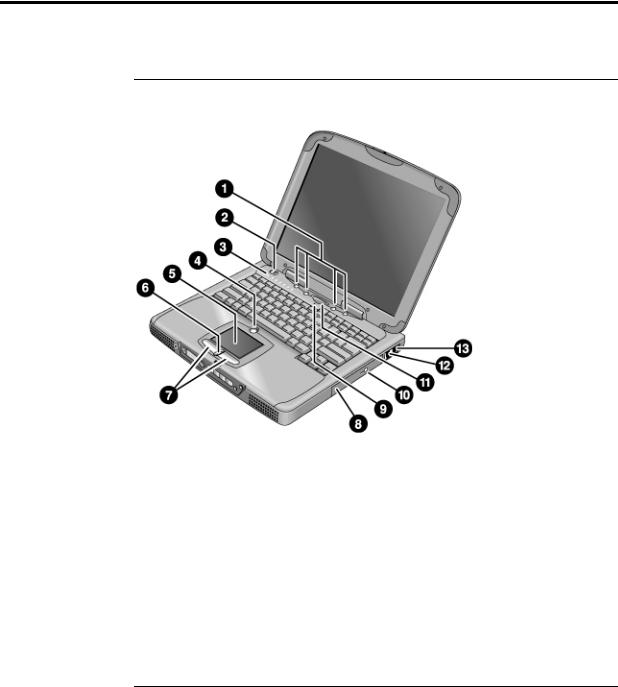
Introducing Your Computer
Identifying Parts of the Notebook
Identifying Parts of the Notebook
Top and right side view
1 |
One-Touch buttons |
8 |
CD-ROM, CD-RW, DVD, or CD-RW/DVD drive |
2 |
Power switch |
9 |
Microphone |
3 |
Status lights (see “Status lights“ on page 20) |
10 |
CD-ROM/DVD eject button |
4 |
Pad Lock touch pad on/off button |
11 |
Blue standby button |
5 |
Touch pad (pointing device) |
12 |
Modem port (on selected models) |
6 |
Scroll up/down toggle |
13 |
LAN port (on selected models) |
7 |
Click buttons |
|
|
16 Corporate Evaluator’s Guide

Introducing Your Computer
Identifying Parts of the Notebook
Front view
14Headphone audio jack
15Status panel mode select button (on selected models)
16Status panel (on selected models)
17Multimedia buttons (on selected models)
18Latch (to open computer)
Corporate Evaluator’s Guide |
17 |
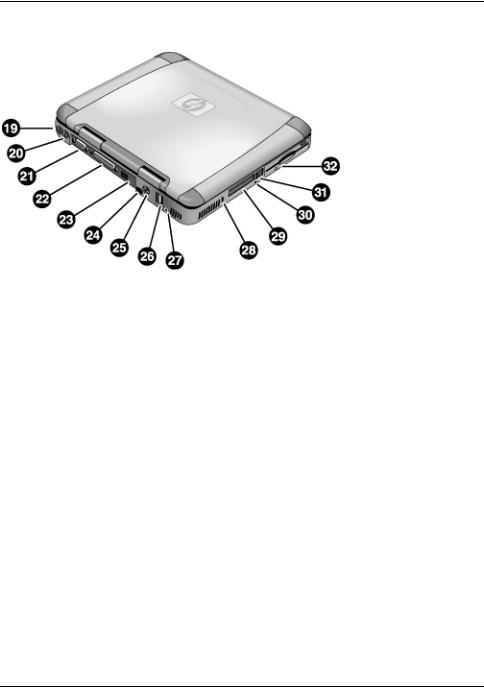
Introducing Your Computer
Identifying Parts of the Notebook
Rear and left side view
19 |
AC adapter (power) jack |
26 |
USB ports |
20 |
PS/2 port (external mouse or keyboard) |
27 |
Microphone jack |
21 |
VGA port |
28 |
Kensington lock slot (security connector) |
22 |
Parallel port |
29 |
PC card slots |
23 |
IEEE1394 port (on selected models) |
30 |
System-off switch (for resetting computer) |
24 |
Infrared port (on selected models) |
31 |
PC card eject buttons |
25 |
TV output port |
32 |
Floppy disk drive |
18 Corporate Evaluator’s Guide

Introducing Your Computer
Identifying Parts of the Notebook
Bottom view
33Battery
34Battery latch
35Expansion RAM cover
36System RAM cover
37Port replicator (docking) connector (on selected models)
38Mini-PCI cover (no user parts inside)
Corporate Evaluator’s Guide |
19 |

Introducing Your Computer
Identifying Parts of the Notebook
Status lights
1Power
2Battery
3Caps lock (capital letters)
4Num lock (numeric keypad)
5Scroll lock
6Floppy disk drive access
7Hard disk drive access
8CD-ROM, CD-RW, DVD, or CD-RW/DVD drive access
20 Corporate Evaluator’s Guide

Introducing Your Computer
Identifying Parts of the Notebook
Multimedia buttons
(Provided for selected models.) The multimedia buttons are on the front of the computer, to the right of the status display. They control the computer’s CD and DVD players, and work much the same way as the controls of a standalone multimedia player.
If the system is turned off (or in standby or hibernate mode), you can still play audio CDs. Slide the multimedia power switch to the left to activate the player without turning on the computer. (See “Managing Power Consumption“ on page 52 for information about standby and hibernate modes.)
1Multimedia power (use when system is off or in standby or hibernate mode)
2Previous track
3Play/pause
4Stop (when computer is on)*, Stop/eject (when computer is off)
5Next track
6Volume control down
7Volume control up
*To eject a CD or DVD, press the eject button on the CD/DVD drive.
When the system is on, it can display onscreen the labels of the multimedia buttons as you press them. To change this:
∙Click Start, Settings, Control Panel, Keyboard (Windows 98 or 2000) or Start, Control Panel, Printers and Other Hardware, Keyboard (Windows XP), then select the Onscreen Display tab.
Corporate Evaluator’s Guide |
21 |

Introducing Your Computer
Identifying Parts of the Notebook
Status panel
(Provided for selected models.) The status panel on the front of the computer provides information about CD playback status, system power management, system date and time, and battery status. Messages are displayed on the 8-character LCD display, and you can switch from one message to another by pressing the mode button to the left of the display.
When the computer is on, these modes are displayed sequentially as you press the mode button:
∙power status: ON, OFF,  (standby), or
(standby), or  (hibernate)
(hibernate)
∙date
∙time
∙battery charge remaining (0% to 100%)
∙CD player status (if CD player is running): shows the track number, play status (playing, paused, or stopped), and time counter
When the computer is off and the CD player is off, you can use the status panel by sliding the multimedia power switch to the left to turn it on. (Remember to turn it off when you are through.)
If you change the Windows time or date (from Control Panel or the taskbar), the change will not appear on the status panel until the next time you start the computer.
If you want to change the format used to display the date or time in the status panel, change it in the BIOS—see “Using the BIOS Setup Utility“ on page 86.
22 Corporate Evaluator’s Guide

Introducing Your Computer
Setting Up the Computer
Setting Up the Computer
To install the battery
Your computer is shipped with the battery installed. If the battery has been removed, you can install it by inserting it into the battery bay on the bottom of your computer. Insert the back edge first, as shown, then press down the front edge until the battery latch clicks shut.
|
Once you have installed the battery, connect the AC adapter to the computer and |
|
recharge the battery while you work. You can also replace a low battery with a charged |
|
one. |
|
|
WARNING |
Do not mutilate, puncture, or dispose of batteries in fire. A battery can burst or |
|
explode, releasing hazardous chemicals. A rechargeable battery must be recycled |
|
or disposed of properly. |
|
|
Corporate Evaluator’s Guide |
23 |
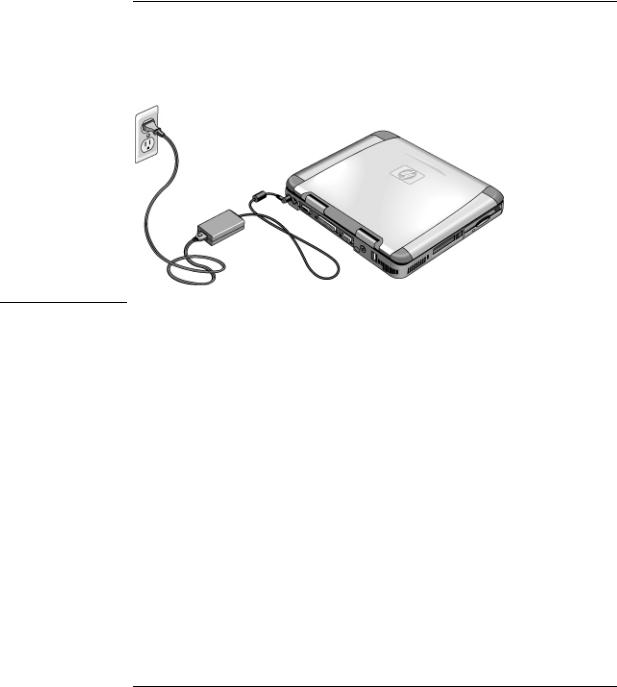
Introducing Your Computer
Setting Up the Computer
To connect AC power
Plug in the AC adapter, then connect the AC adapter to the rear of the computer. The battery starts charging.
CAUTION |
Use only an HP AC adapter intended for this product, either the adapter that came |
|
with the computer or another authorized HP adapter. Using an unauthorized AC |
|
adapter can damage the computer and may void your warranty. Refer to the |
|
warranty statement for your product. |
|
|
24 Corporate Evaluator’s Guide
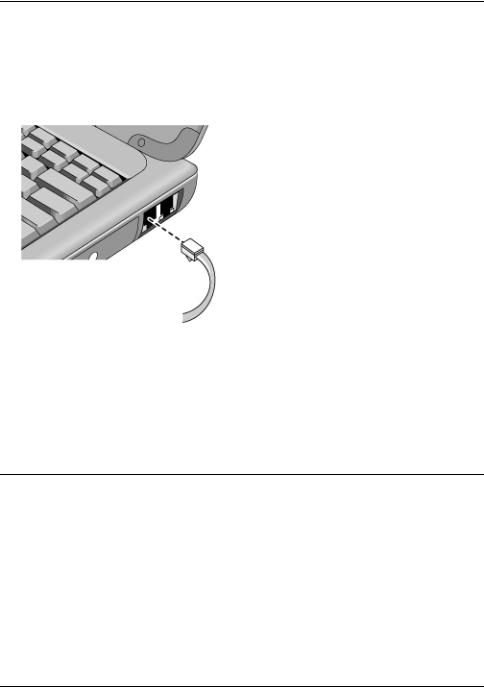
Introducing Your Computer
Setting Up the Computer
To connect a phone line
Selected models of the HP notebook PC include a built-in modem. If you prefer, you can instead use a PC card modem or an external modem to connect a phone line.
1.Plug one end of the phone line into the modem phone jack on the computer. Be sure it clicks into place.
|
2. Plug the other end of the phone line into a telephone jack. (If the phone line does not |
|
fit your telephone jack, you may need to use an adapter.) |
|
|
CAUTION |
Your built-in modem may not work with multiple phone lines or a private branch |
|
exchange (PBX). It cannot be connected to a coin-operated telephone, and it does |
|
not work with party lines. Some of these connections may result in excess electrical |
|
voltage and could cause a malfunction in the internal modem. Check your |
|
telephone line type prior to connecting your phone line. |
|
|
To turn on the computer
Press the blue standby button located above the center of the keyboard. Windows starts automatically. If you are turning on the computer for the first time, go to “To set up Windows,” below.
The power status light next to the power switch (see “Status lights“ on page 20) reports the following:
∙ steady green light: computer is on
∙ steady amber light: computer is in standby mode
Corporate Evaluator’s Guide |
25 |

Introducing Your Computer
Setting Up the Computer
|
∙ no light: computer is off or in hibernate mode |
|
See “Managing Power Consumption“ on page 52 for additional information. |
|
|
Hint |
If your computer does not turn on when operating on battery power, the battery may be |
|
out of power. Plug in the AC adapter and press the standby button again. |
|
|
To set up Windows
Your HP notebook has Microsoft Windows—either Windows 98, Windows 2000, or Windows XP—preinstalled on the hard disk drive. The first time you turn on your computer, a Windows Setup program will automatically run so that you can customize your setup.
Before you begin, connect the AC adapter to your notebook, since your battery may not be sufficiently charged to complete the Windows setup. Also, be sure to connect the notebook to a phone line—see “To connect a phone line“ on page 25.
1. Press the blue standby button. The Windows Setup program starts automatically. 2. Follow the instructions as they appear on the screen.
During setup, you are prompted to enter a user name and accept the License
Agreement.
You can also register your computer at this time. Follow the instructions on the screen during setup.
3. If your computer has a modem, check the modem’s country or region settings:
∙ Windows 98: click Start, Settings, Control Panel, double-click Modems, then click Dialing Properties.
∙ Windows 2000: click Start, Settings, Control Panel, double-click Phone and Modem Options, then click Edit on the Dialing Rules tab.
∙ Windows XP: click Start, Control Panel, Printers and Other Hardware, Phone and Modem Options, then click Edit on the Dialing Rules tab.
26 Corporate Evaluator’s Guide

Note
Note
Note
Introducing Your Computer
Setting Up the Computer
You may be required to enter your Windows Product key. To locate it, look on the Certificate of Authenticity packaged with the Microsoft Windows manual, or look for a sticker in the battery compartment.
If you have any connection problems with your modem, try redialing. If that doesn’t work, you can skip registration for now.
To register your computer
Be sure to register your computer. Registering is free and fast, and it ensures you will receive quicker, more personalized support. The information you provide during registration will be used to provide you with better products and services.
You can register while setting up Windows, or later in any of three ways: by modem, by phone, or by fax. For some countries and models, an HP notebook registration icon is available on the desktop.
By modem
If you have Windows 98 or XP, you are automatically prompted to register. To register by modem, see that the phone is connected, then follow the onscreen instructions.
If you have Windows 2000, you are not prompted to register, but you can register by modem if you double-click the HP Notebook Registration icon on the desktop or click the Register link in the Windows 2000 welcome screen. See that the phone line is connected and follow the onscreen instructions.
If you choose not to register right away, you can register by modem later by doubleclicking the Registration icon on the desktop (if available).
In Windows 2000, if the registration application is launched from a reminder (e.g., from the Microsoft Task Scheduler), it may fail to find a phone number for your country. In this case, double-click the HP Notebook Registration icon on the desktop and the application will succeed in finding a phone number to register successfully.
If you encounter a busy signal while attempting to register by modem, the registration client may suspend with an hourglass icon. Click the Back button and dial-out again.
If your computer does not have a built-in modem, you can register after you set up a PC card modem or an external modem—or you can register by phone or fax.
Corporate Evaluator’s Guide |
27 |

Introducing Your Computer
Setting Up the Computer
By phone
You can call your HP Customer Care Center and register by phone. See “To call HP for service and support“ on page 129 for the phone number.
By fax
If a printer is connected to your computer, you can print a registration form and fax it to HP. Double-click the HP Notebook Registration icon on the desktop (if available), and print the registration form. You will find the fax number on the form.
By completing registration, you will:
∙Record your ownership of the computer with Hewlett-Packard and gain access to service, support, and information.
∙Record your ownership of the Windows 98 or XP operating system with Microsoft. If you have Windows 2000, please contact Microsoft separately to register the operating system.
28 Corporate Evaluator’s Guide

Introducing Your Computer
Setting Up the Computer
To connect to an Internet Service Provider
Before you can connect to the Internet, you need to set up an account with an Internet Service Provider (ISP). In some countries, Hewlett-Packard provides easy Internet signup so that you can connect quickly to an ISP.
1.Connect your built-in modem. (If your computer does not have a built-in modem, you can instead use a PC card modem or an external modem.)
2.Click Start, Programs, Online Services (Windows 98 or 2000) or Start, All Programs, Easy Internet Signup (Windows XP), and select one of the listed ISPs. This begins the registration process for the ISP you have chosen.
OR
If available, double-click the Connect to the Internet or Easy Internet Signup desktop icon. This launches the Internet Connection or New Connection wizard, which helps you locate an ISP in your area, transfer an existing Internet account to this computer, or set up an Internet connection manually.
If AOL is your ISP, click Start, Settings, Control Panel, and double-click Internet Options (Windows 98 or 2000), or click Start, Control Panel, Network and Internet Connections, Internet Options (Windows XP). Select the Connections tab, then select either “Dial whenever a network connection is not present” or “Always dial my default connection.”
You can also make arrangements with an ISP of your choice for Internet connection.
Corporate Evaluator’s Guide |
29 |
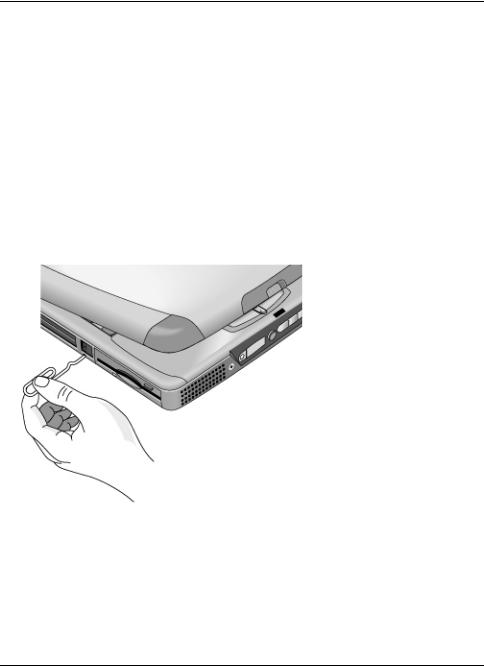
Introducing Your Computer
Setting Up the Computer
To reset your computer
If Windows or your computer stops responding, you can reset the computer and restart Windows.
1.If possible, shut down Windows: click Start, Shut Down, Shut down (Windows 98 or 2000) or Start, Turn Off Computer, Turn Off (Windows XP).
–or, if this fails–
Press CTRL+ALT+DEL, then click Shut Down.
2.If the computer does not shut down, slide and hold the power switch for five seconds, then release it.
3.If the computer still does not shut down, insert a pin or straightened paper clip into the system-off switch on the left side of the computer, underneath the PC card eject buttons.
4.After the computer shuts down, press the blue standby button to turn the computer on again.
30 Corporate Evaluator’s Guide
